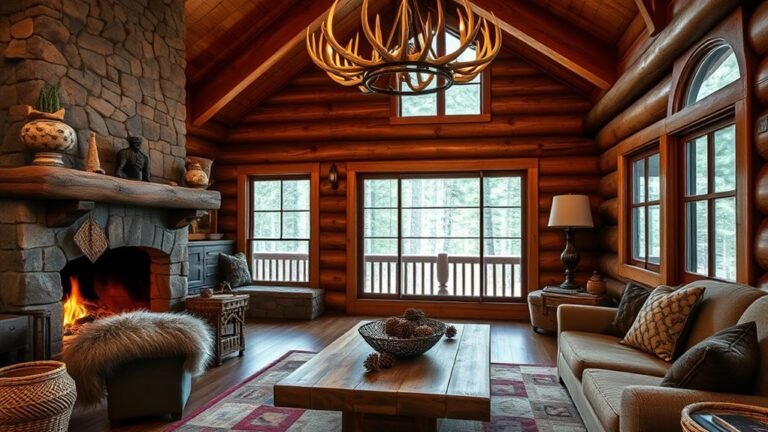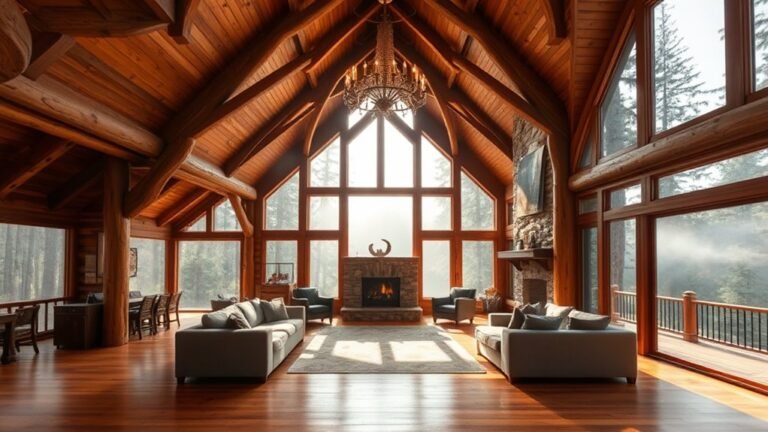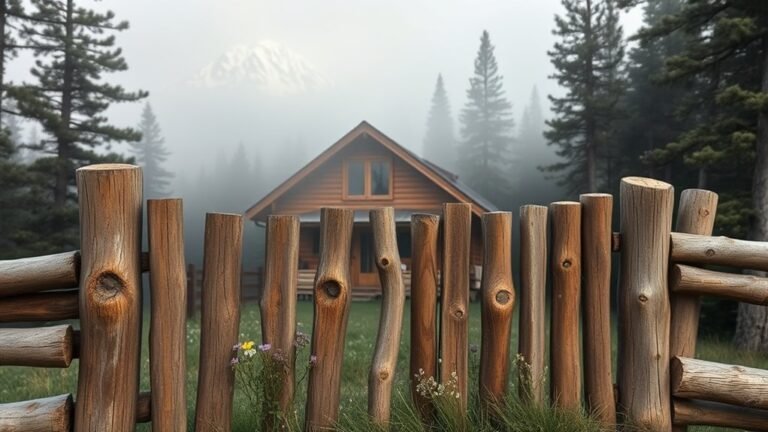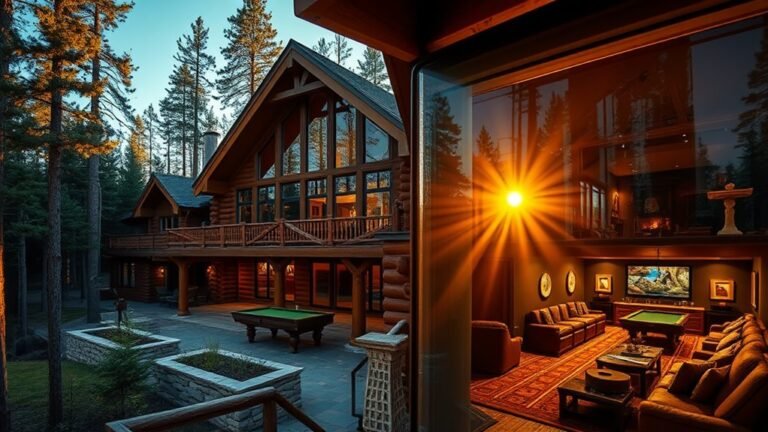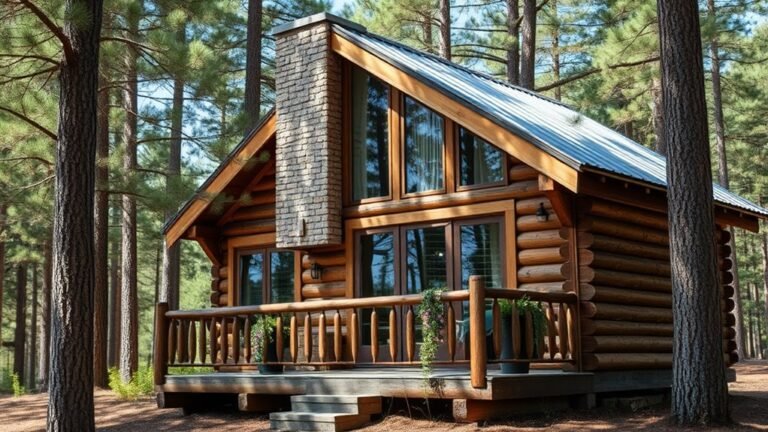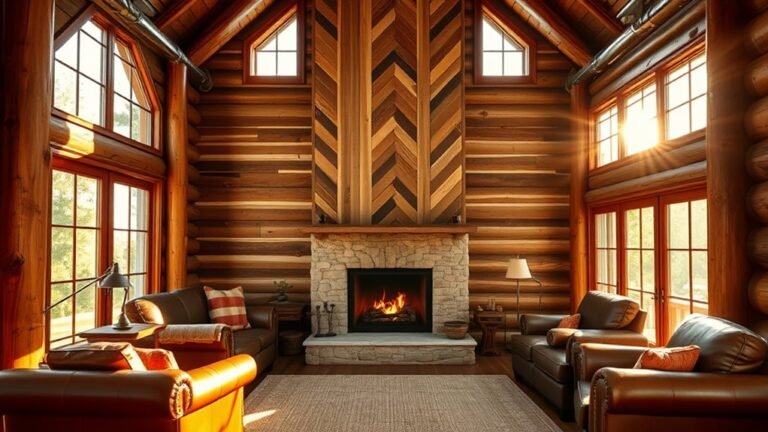23 Log Cabin Landscaping With Wildflowers
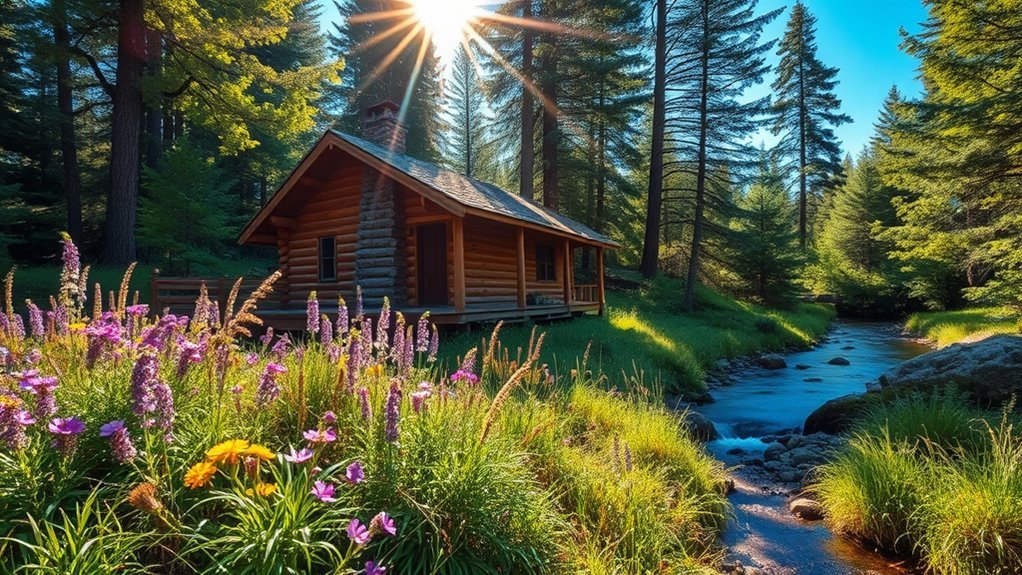
Incorporating wildflowers into your log cabin landscaping can enhance its natural appeal through biodiversity and low-maintenance beauty. Selecting native flowers creates a vibrant space that attracts pollinators and complements your cabin’s rustic charm.
Choose wildflowers suited for your area to design a captivating garden. This seamless integration offers an inviting atmosphere while blending with the surroundings.
Choosing the Right Wildflowers
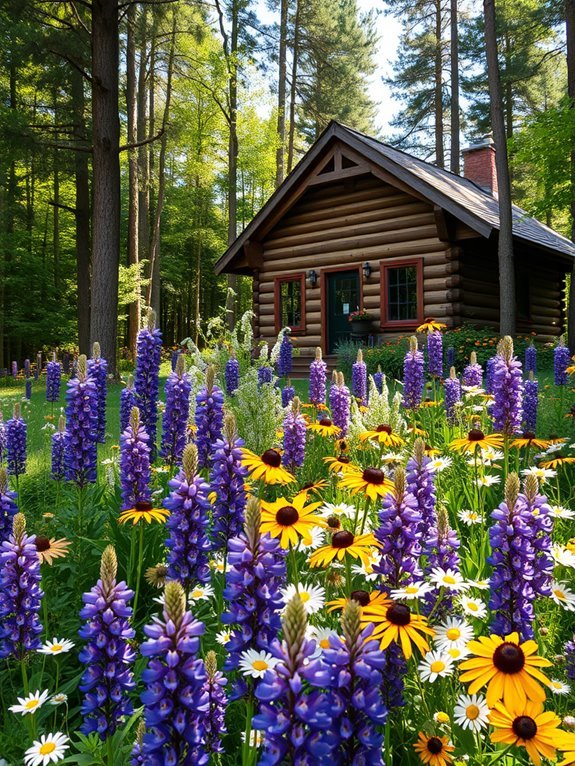
To choose wildflowers for your log cabin landscape, consider your local climate and soil type. Avoid selecting flowers that need sunny conditions if you live in a rainy area like Washington.
Observe the sunlight, moisture, and wind exposure around your cabin to find flowers that will thrive. Assess your soil type—sandy, clayey, or loamy—and possibly conduct a soil test to ensure compatibility with your chosen flowers.
Once you’ve established these basics, consider the colors and heights of the flowers to create visual interest.
Be mindful of plant compatibility, such as not placing tall sunflowers next to shorter violets. Selecting the right wildflowers can transform your cabin into a picturesque setting. Happy planting!
Native Wildflowers for Your Area
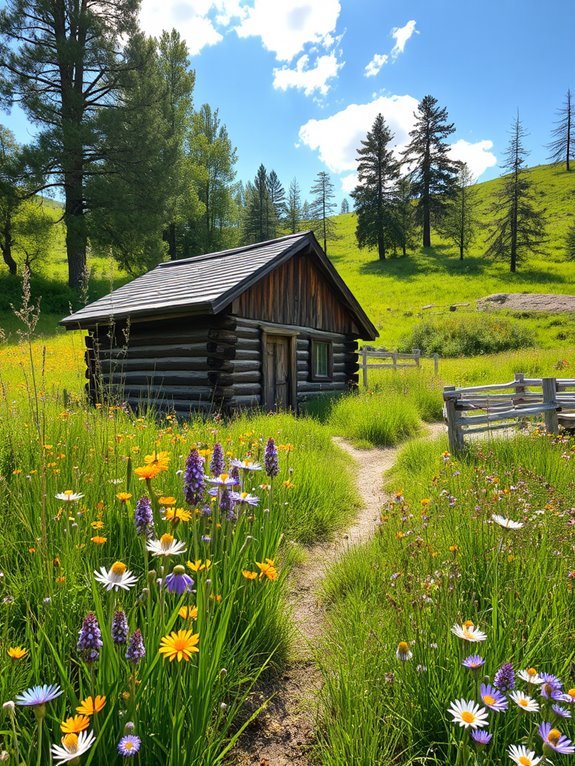
Choosing native wildflowers for your area enhances your log cabin’s landscape and supports local ecosystems.
These plants are well-suited to your soil and climate, requiring less water and care, while attracting pollinators like bees and butterflies.
Research wildflowers native to your state, such as coneflowers, black-eyed Susans, or wild indigo, to find beautiful options.
Plant them in clusters to create a vibrant garden, adding charm to your cabin.
Imagine enjoying your morning coffee while watching butterflies flutter around—it’s pure magic!
Embrace nature, and your log cabin landscape will thrive.
Color Schemes for Wildflower Gardens
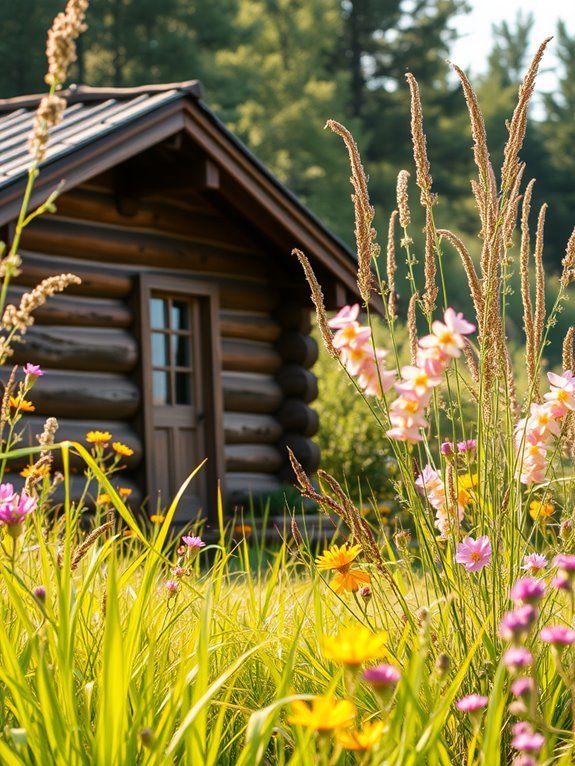
To create a stunning wildflower garden that complements your log cabin, start by selecting a color scheme that mirrors your style and surroundings. Consider your cabin’s colors—whether warm browns and reds or cool grays and greens. Choose wildflowers that match or contrast these tones. For warmth, opt for sunny yellows, vibrant oranges, and soft reds with flowers like black-eyed Susans and blanket flowers. For a serene feel, choose blues, purples, and whites, such as delphiniums and asters. Mix various shades of the same color for depth and complexity, and add unexpected splashes of color for liveliness. With planning, your garden will visually delight and enhance your cabin’s charm. Incorporating elements like natural fibers in garden decor can enhance the rustic aesthetics and create a cohesive look with your cabin’s interior design.
Layering Wildflowers for Depth
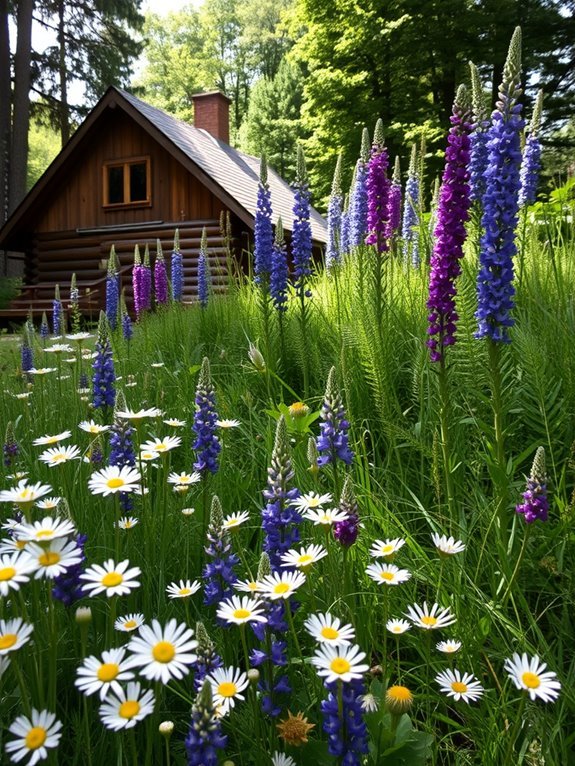
To create a captivating wildflower garden with depth, layer plants for dimension.
Choose a mix of wildflowers with varying heights, placing taller varieties like sunflowers at the back to let smaller blooms such as daisies or violets stand out in front.
Consider bloom times to ensure all-season vibrancy, mixing early, mid, and late-season flowers.
Add texture with feathery grasses or leafy foliage to enhance contrast and make flowers pop.
Edible Wildflowers in Landscaping
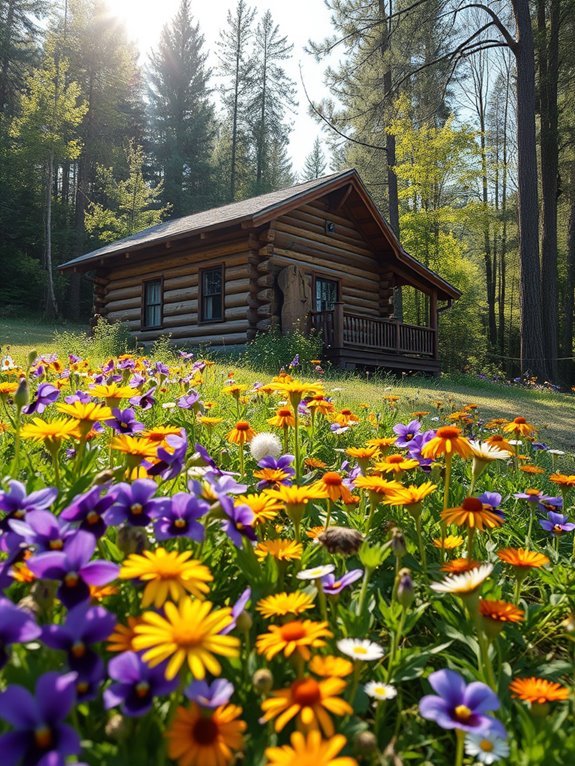
Consider adding edible wildflowers to your landscape for both beauty and flavor.
Imagine stepping outside to pick flowers for your salad or a refreshing drink—it’s a culinary adventure at home!
Here are some edible wildflowers to consider:
- Nasturtiums: Peppery flavor perfect for salads.
- Calendula: Bright petals with a hint of spice.
- Chive Flowers: Mild onion taste ideal for garnishing.
- Borage: Cucumber-like flavor great for beverages.
Planting these enhances your landscape and attracts bees and butterflies, creating a vibrant ecosystem.
Impress friends with your homegrown treats and enjoy the blend of beauty and taste in your garden!
Wildflower Pathways and Walkways
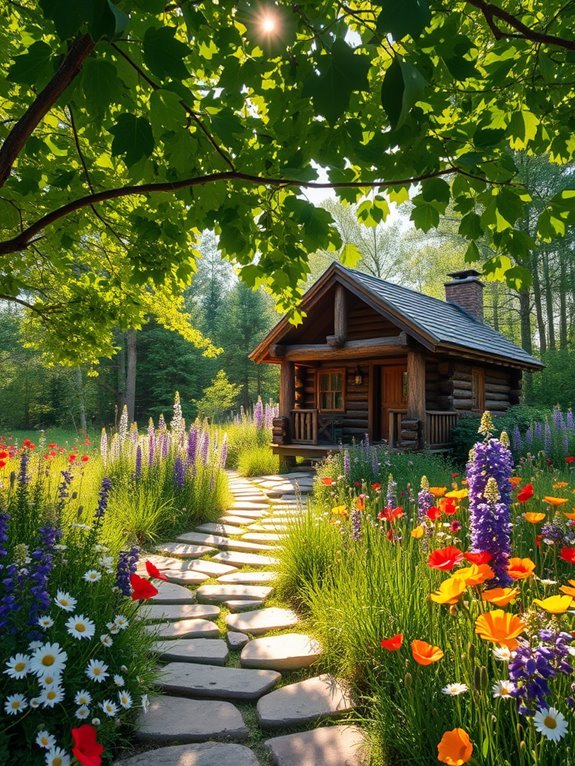
Enhance your log cabin landscape by creating wildflower pathways and walkways. Imagine stepping out to a vibrant trail of wildflowers, inviting you and your guests to explore.
Begin by mapping your path using stones or wood for a rustic touch. Choose a variety of wildflowers that bloom from spring to fall, like daisies, violets, and poppies, to ensure continuous color and attract butterflies and bees.
Include stepping stones or benches for rest and enjoyment. Your wildflower pathways will become a captivating focal point, encouraging exploration and delight.
Creating a Wildflower Meadow
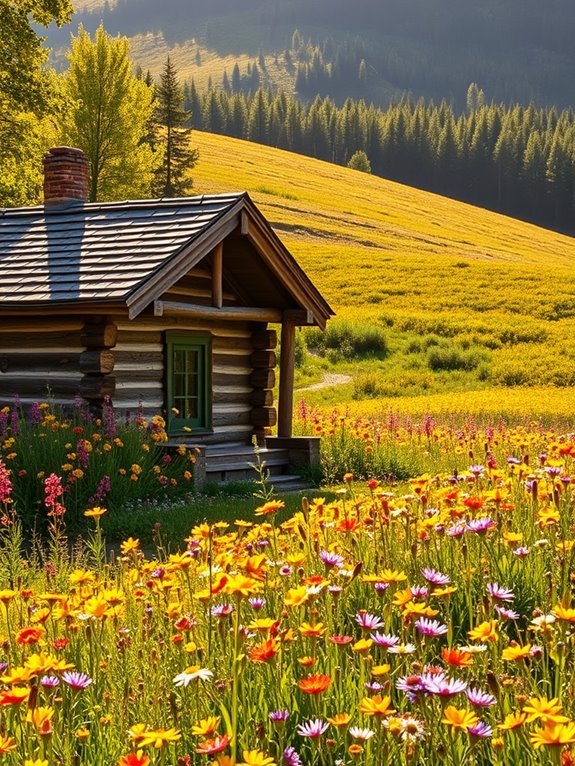
Transform an ordinary yard into a vibrant wildflower meadow with some planning and effort. Start by selecting a sunny spot, then prepare the soil and choose native wildflower seeds suited to your climate.
Here’s how to begin:
- Clear the area: Remove grass and weeds to reduce competition.
- Choose your seeds: Opt for native varieties to support local wildlife.
- Sow your seeds: Evenly scatter seeds and lightly rake for good soil contact.
- Water wisely: Water gently, allowing for occasional droughts as wildflowers prefer.
With patience and care, your yard will soon be a stunning wildflower meadow, attracting butterflies, bees, and admiration from neighbors.
Container Gardening With Wildflowers
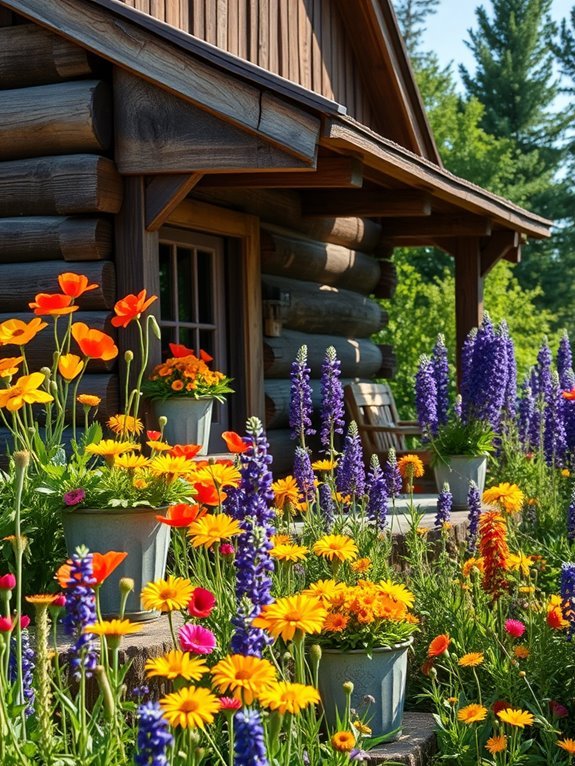
Create a wildflower oasis on your patio or balcony with container gardening.
Choose rustic pots or colorful planters for zinnias, cosmos, and sunflowers, which thrive in containers. Use quality potting soil for good drainage and place in a sunny spot.
Mix different wildflowers for a stunning display, ensuring enough space to prevent overcrowding. Water regularly with care.
Consider incorporating earthy tones in your planters to complement the wildflowers and create a cohesive look with your surroundings.
Soon, you’ll have a vibrant patch of wildflowers that will brighten your space.
Grab your pots and start planting—your patio will be the talk of the town!
Attracting Pollinators With Wildflowers
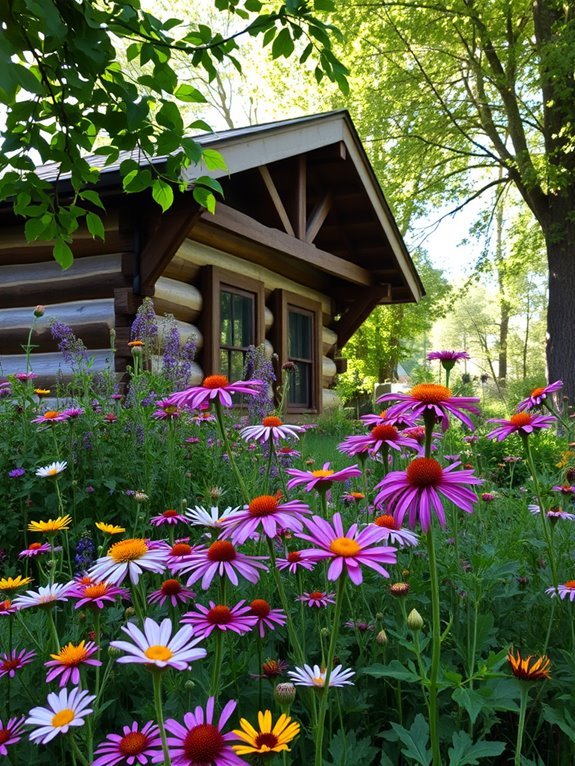
To attract pollinators to your wildflower garden, choose the right plant varieties to create an irresistible buffet for butterflies, bees, and more.
Select a mix of colors, shapes, and sizes for continuous blooms. Consider these options:
- Coneflower (Echinacea): Attractive to bees and butterflies.
- Black-eyed Susan (Rudbeckia): Their sunny petals welcome pollinators.
- Milkweed (Asclepias): Essential for attracting Monarch butterflies.
- Wild Bergamot (Monarda): Fragrant blooms attract bees and hummingbirds.
Plant in clusters for better visibility and avoid pesticides.
With these wildflowers, you’ll soon have a buzzing paradise. Happy gardening!
Wildflower Borders and Edging
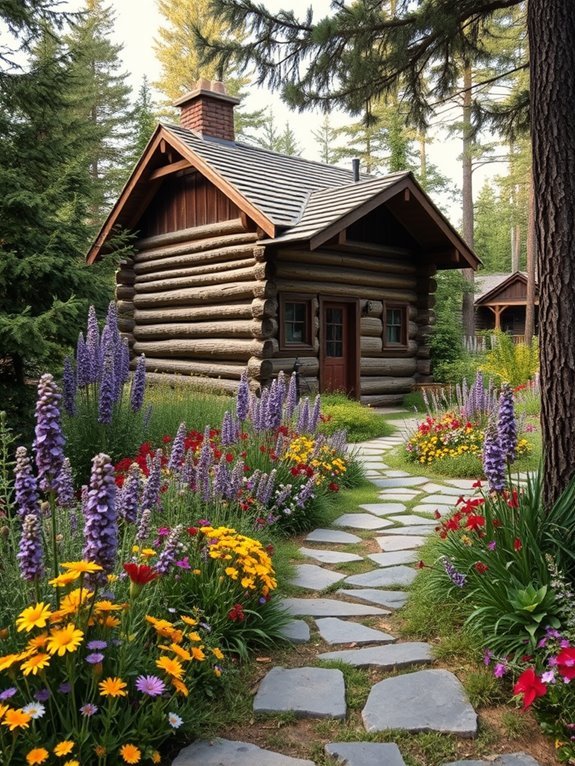
Wildflowers can enhance your garden as borders and edging, offering vibrant colors and scents. They soften hard edges and invite exploration.
Use a mix of short wildflowers, like creeping thyme or blue-eyed grass, along walkways, and taller ones, like coneflowers and black-eyed Susans, at the back for visual appeal and insect habitats.
Wildflower borders reduce weeds, provide natural barriers, and require less maintenance than traditional gardens.
With creativity, your landscape will be lively and inviting, making your log cabin feel like home.
Seasonal Wildflower Planting Guide
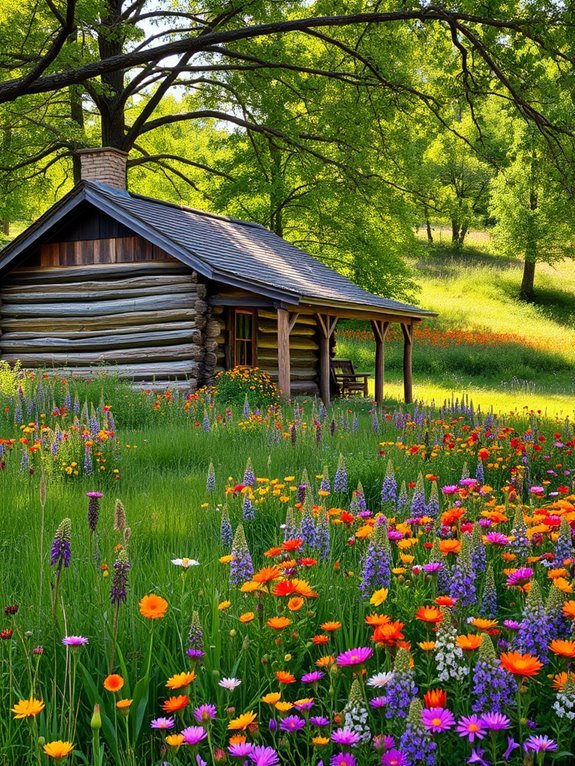
Timing is crucial for a successful wildflower garden. Here’s when to plant for the best blooms:
- Spring: Plant seeds after the last frost to awaken your garden.
- Summer: If you missed spring, plant in early summer and water regularly for a vibrant display.
- Fall: Ideal for perennials, allowing them to settle in cooler months for a spring bloom.
- Winter: Scatter seeds on snow for a surprising bloom in spring.
Regardless of the season, enjoy the process.
Your garden will reward you with a colorful array and attract butterflies. Happy planting!
Maintenance Tips for Wildflower Gardens
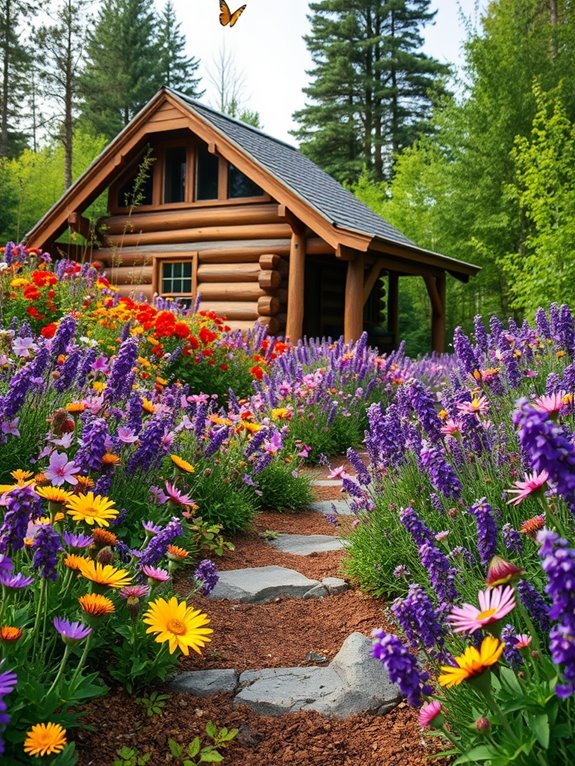
Maintaining a wildflower garden is simple and rewarding with a few key practices.
Monitor weeds early to prevent nutrient and sunlight competition. Water sparingly, giving extra moisture during dry spells without overwatering.
Deadhead old blooms to encourage new growth and maintain a fresh appearance. Attract birds and butterflies by adding native plants.
Embrace the natural cycle, allowing some plants to look ragged at season’s end. Enjoy the process and let your garden be a vibrant, joyful space year-round.
Happy gardening!
Wildflower Ground Covers
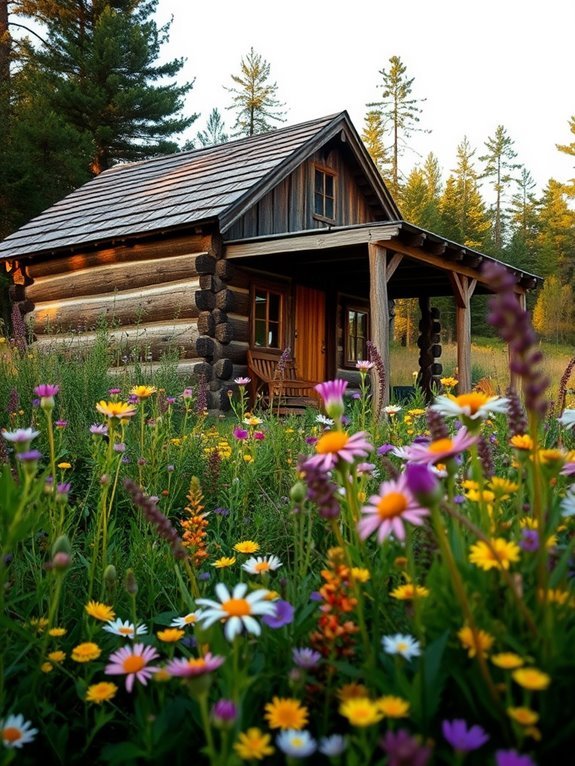
Wildflower ground covers enhance your landscape’s beauty and benefit the environment. Instead of plain grass, enjoy a colorful bloom carpet that creates a thriving ecosystem.
Here’s why to choose wildflower ground covers:
- Soil Health: They prevent erosion, maintaining soil integrity.
- Pollinator Paradise: They attract bees, butterflies, and other beneficial insects.
- Low Maintenance: Once established, they need less water and care than lawns.
- Seasonal Color: Experience vibrant colors year-round as different flowers bloom each season.
Incorporating Wildflowers in Rock Gardens
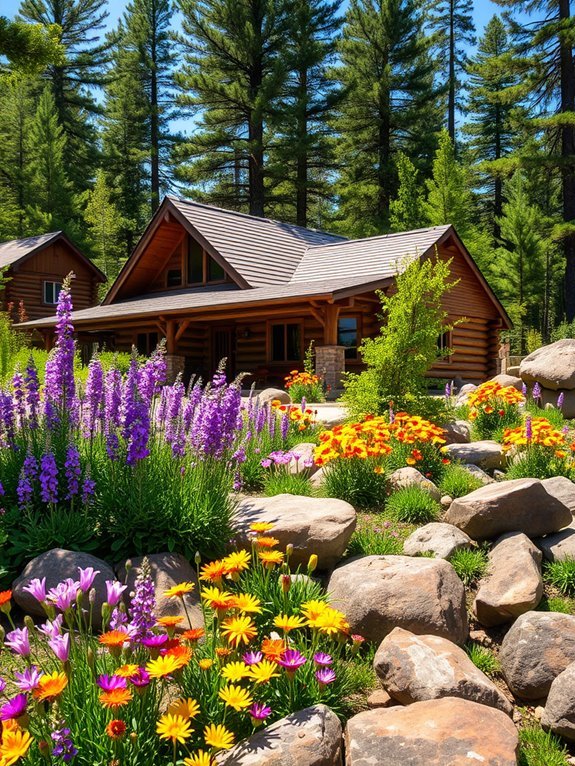
Adding wildflowers to rock gardens enhances color and creates a striking contrast with the stones. Imagine vibrant blooms emerging through cracks, swaying in the breeze, and capturing attention. Choose from various wildflowers, like daisies and bluebells, to enliven your garden.
Select low-growing wildflowers suited for rocky terrain, as they thrive in poor soil—ideal for rock gardens. Combine different colors and heights for visual appeal. Pair yellow coreopsis with soft lavender wild lupine for a delightful effect.
Consider your garden’s sun exposure, as some wildflowers prefer sun while others need shade. Plant in clusters for a natural look, as if nature organized a gathering among the stones.
Grab your gardening gloves and start creating a lively, inviting space that brings joy to you and onlookers, while giving you more reasons to enjoy the outdoors.
Companion Planting With Wildflowers
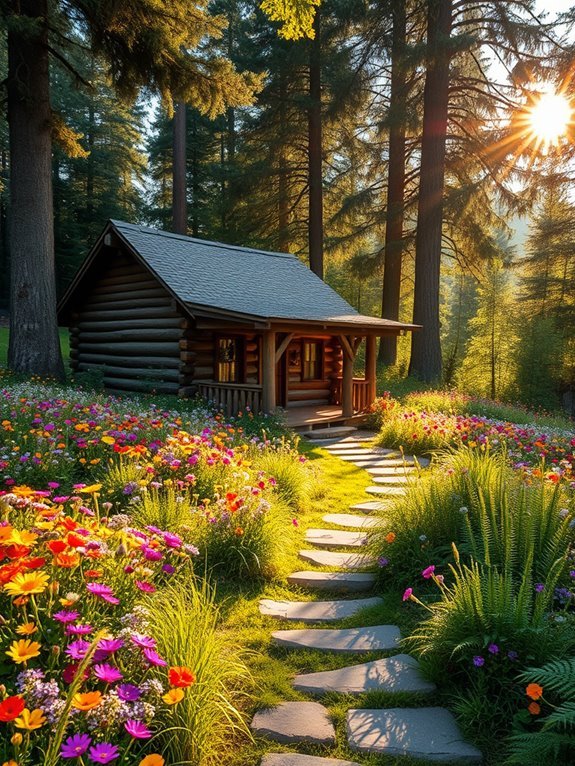
Wildflowers can thrive when paired with other plants in your garden. Companion planting isn’t just for veggies; it benefits wildflowers too, creating a vibrant and diverse space.
Consider these combinations:
- Wildflower Mix with Ornamental Grasses: Grasses’ soft textures complement wildflowers’ vivid colors.
- Wildflowers and Herbs: Pairing with basil or mint attracts beneficial insects for pollination.
- Wildflowers with Native Shrubs: This creates a layered effect and offers habitat for wildlife.
- Wildflowers and Perennials: Adds longevity with blooms across seasons.
These combinations turn your garden into a colorful, textured landscape. Happy planting!
Wildflower Gardens for Wildlife Habitat
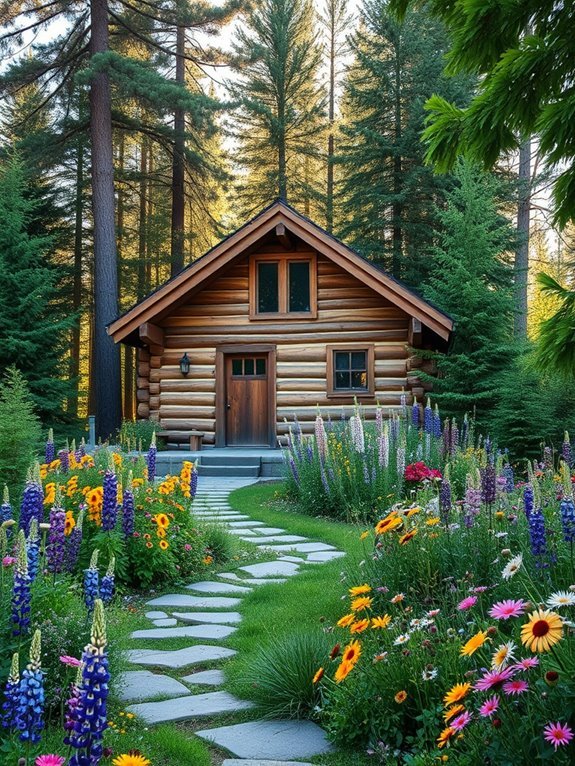
Creating a wildflower garden enhances your landscape and provides vital habitat for local wildlife. Picture a colorful patch alive with bees and butterflies! Attract these creatures by choosing native wildflowers suited to your climate and soil. Native plants are perfectly adapted to your area, making them ideal for your wildlife-friendly garden.
Planting various wildflowers offers a feast for pollinators and other creatures. Sunflowers, coneflowers, and black-eyed Susans provide food and shelter, creating a cozy home for birds, bees, and even bunnies.
Wildflower gardens require less upkeep than traditional lawns, giving you more time to relax and enjoy the view.
As seasons change, your garden will attract diverse wildlife year-round. You might even become a birdwatcher or butterfly enthusiast without trying!
Designing a Wildflower Cottage Garden
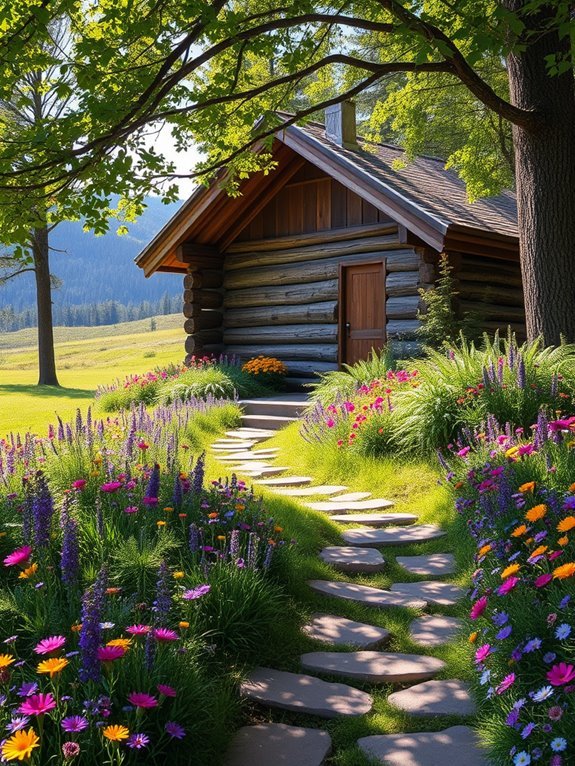
Designing a wildflower cottage garden is the perfect way to create a vibrant, charming space.
Picture a colorful sanctuary buzzing with life and delightful scents. To make your garden magical, consider these key elements:
- Choose the Right Flowers: Mix perennials and annuals for continuous blooms.
- Create Layers: Plant taller flowers in the back and shorter ones in front for depth.
- Add Pathways: Use stepping stones or mulch to guide visitors.
- Incorporate Seating: A cozy bench invites relaxation and enjoyment.
Let your creativity flow as you design, experimenting with colors and textures.
Add a whimsical garden gnome if desired. Embrace the natural, carefree look of a wildflower cottage garden for a charming retreat and joyful escape from daily life.
Using Wildflowers for Privacy Screens
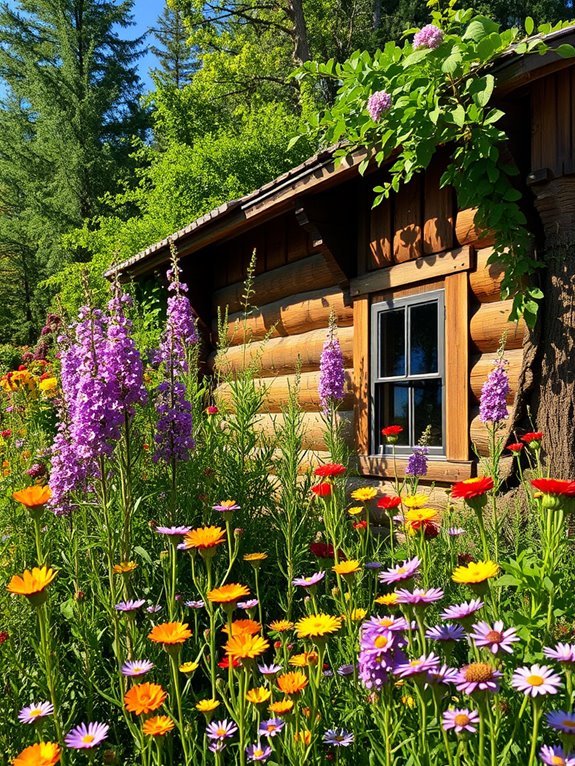
Create a natural privacy screen by using wildflowers that offer both beauty and habitat for wildlife.
Choose tall species like sunflowers or hollyhocks for height, and mix in shorter varieties like black-eyed Susans or lavender for depth.
Plant them in clusters with ample space for growth.
To ensure continuous blooms, select species that flower in different seasons, attracting bees and butterflies to your garden.
Wildflower Arrangements for Cabin Décor
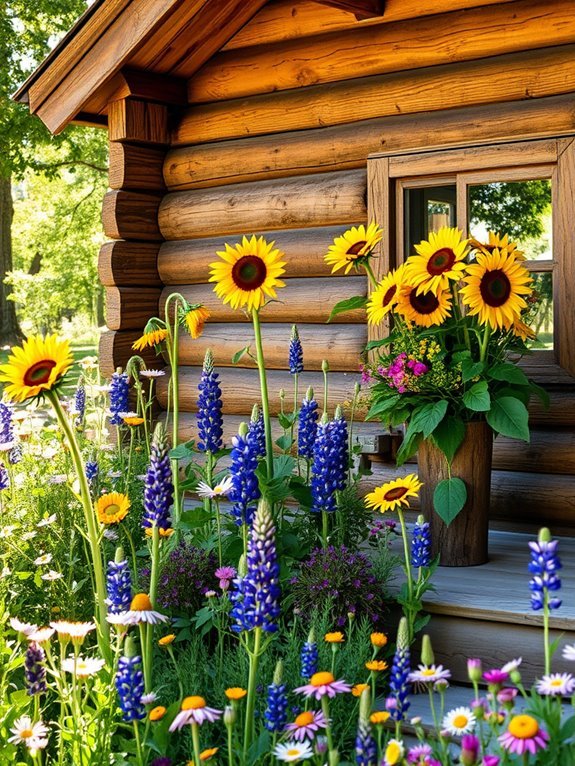
Wildflowers can transform your cabin into a cozy, inviting space with their cheerful colors and delightful scents, bringing nature indoors.
Create arrangements that reflect your style with these ideas:
- Mason Jar Vases: Fill mason jars with assorted wildflowers for a rustic touch on dining tables or window sills.
- Hanging Bouquets: Hang arrangements from the ceiling to add visual interest and make the space feel larger.
- Wildflower Wreaths: Craft a wreath for your front door or wall art, offering a warm welcome to visitors.
- Seasonal Arrangements: Change arrangements seasonally, using sunflowers in summer and evergreen sprigs in winter for a fresh look year-round.
Water Features With Wildflowers
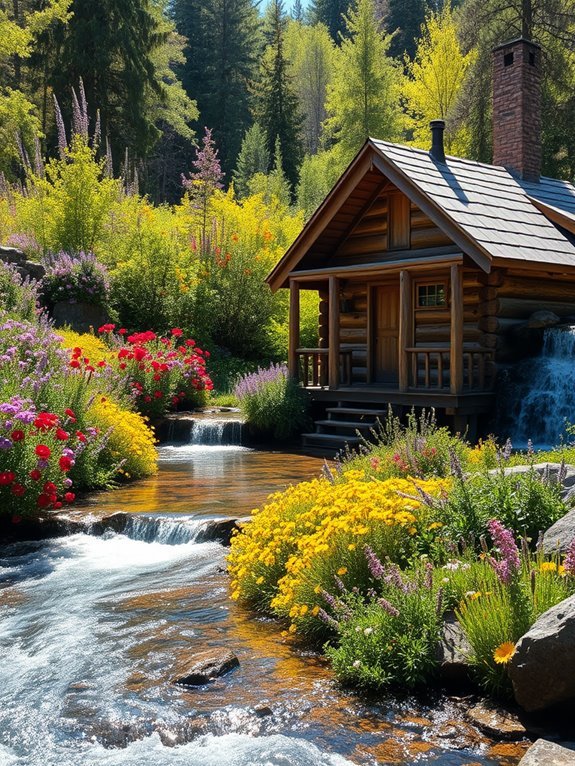
Enhance your cabin’s outdoor space by combining wildflowers with water features.
Picture a gentle stream flowing through your yard, bordered by vibrant wildflowers like bluebells or daisies that attract butterflies and bees. Enjoy your morning coffee as butterflies flutter around your water feature, creating a fairytale ambiance.
For ponds, plant wildflowers around the edges to soften the landscape and create a serene escape. You might even spot a frog or two, adding whimsy to the scene.
The soothing sound of water paired with the rustling wildflowers offers a perfect soundtrack for your retreat. Embrace this natural beauty to craft a delightful oasis that will impress friends and family!
Wildflower Grasses for Texture
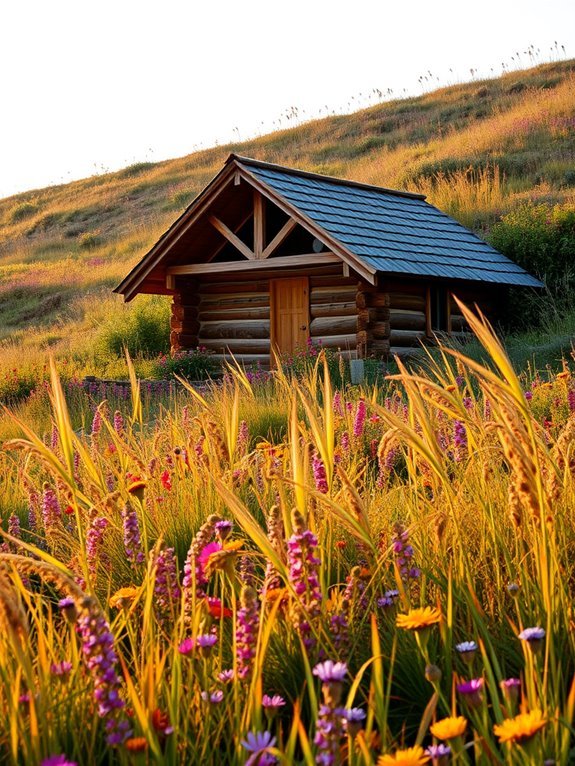
Integrating wildflower grasses into your landscape adds texture and movement, enhancing your cabin’s outdoor space.
The gentle sway of grasses in the breeze creates a whimsical effect, attracting local wildlife and transforming your yard into a lively haven.
Consider these options:
- Little Bluestem: Features blue-green hues that turn golden in fall.
- Switchgrass: Offers tall, airy structure for dramatic framing.
- Prairie Dropseed: Provides fine foliage with a soft, delicate texture.
- Buffalo Grass: Drought-tolerant and low-maintenance, offering a lush green carpet.
DIY Wildflower Seed Bombs
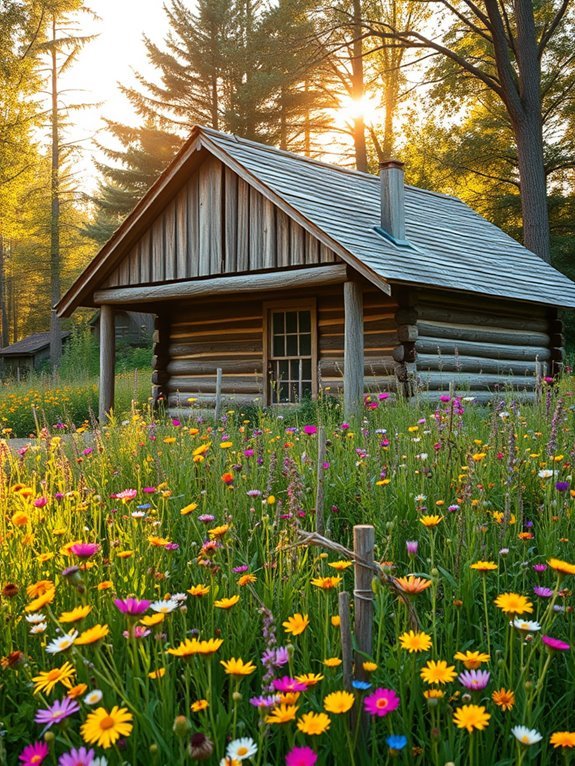
Creating a vibrant wildflower garden is easy with DIY seed bombs.
Gather wildflower seeds, clay powder, and compost or potting soil. Mix one part seeds with three parts compost and one part clay in a bowl. Add water until the mixture holds together but isn’t soggy.
Form small balls, about marble-sized, and let them dry for a day or two. Toss them into sunny garden spots or share with friends.
Enjoy the colorful blooms in a few weeks—it’s like hosting a surprise party in your garden! Happy planting!
Photography Tips for Wildflower Landscapes
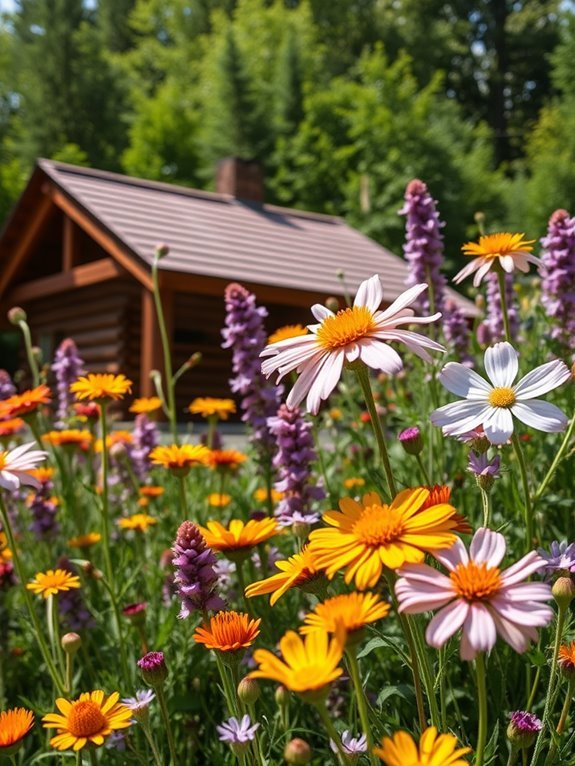
Capture the beauty of wildflower landscapes with these photography tips:
- Lighting: Shoot in early mornings or late afternoons for soft, golden light that enhances the flowers.
- Perspective: Get low to the ground to show flowers against the sky.
- Frame: Fill the frame by getting close to highlight details.
- Depth of Field: Blur the background to make flowers stand out.
Additional tips:
- Use a tripod for stability.
- Apply the rule of thirds for better composition.
- Capture movement in a breeze for a dynamic touch.
- Be patient for perfect lighting and flower alignment.
With these tips, your wildflower photos will impress. Enjoy your photography adventure!
Frequently Asked Questions
How Can I Prevent Weeds in My Wildflower Garden?
To prevent weeds in your wildflower garden, maintain healthy soil, use mulch, and regularly remove any emerging weeds. Plant your wildflowers densely to outcompete weeds, and consider using landscape fabric for added protection.
What Is the Best Time to Plant Wildflower Seeds?
“April showers bring May flowers,” so plant your wildflower seeds in spring after the last frost. This timing helps guarantee ideal germination and blooming, giving your garden a vibrant display throughout the warmer months ahead.
How Do I Choose Wildflowers for Shady Areas?
To choose wildflowers for shady areas, look for species that thrive in low light. Check local gardening resources or nurseries for shade-tolerant options, and consider your soil type to guarantee successful growth.
Can Wildflowers Be Grown in Urban Environments?
Yes, you can grow wildflowers in urban environments. Choose native species that thrive in your local climate, and look for sunny spots or well-drained areas. They’ll attract pollinators and beautify your space while requiring minimal maintenance.
What Common Pests Affect Wildflowers and How Do I Manage Them?
Pests can be like uninvited guests at a party, ruining the fun. You’ll often face aphids, caterpillars, and beetles. To manage them, use organic insecticides, introduce beneficial insects, or handpick them off your plants.
Conclusion
Transform your log cabin into a wildflower paradise by selecting native blooms and layering them for depth. This creates a beautiful, low-maintenance landscape that attracts butterflies and bees. Imagine enjoying your morning coffee amidst vibrant colors and sweet scents. With some creativity, your outdoor space can become a lively, picturesque retreat. Let’s get planting and bring your wildflower dreams to life!

